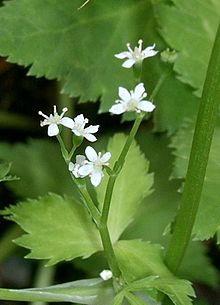Cryptotaenia japonica
| Cryptotaenia japonica | |
|---|---|

| |
| Scientific classification | |
| Kingdom: | Plantae |
| Clade: | Tracheophytes |
| Clade: | Angiosperms |
| Clade: | Eudicots |
| Clade: | Asterids |
| Order: | Apiales |
| Family: | Apiaceae |
| Genus: | Cryptotaenia |
| Species: | C. japonica
|
| Binomial name | |
| Cryptotaenia japonica | |
| Synonyms[1] | |
| |
Cryptotaenia japonica, commonly called mitsuba, Japanese wild parsley and Japanese honewort among other names, is a herbaceous perennial plant in the celery family native to Japan, Korea and China.[2] The plant is edible and is commonly used as a garnish and root vegetable in Japan,[3] and other Asian countries.[4] It is sometimes considred a subspecies of Cryptotaenia canadensis as Cryptotaenia canadensis subsp. japonica.[5]
Description[edit]
Growing 30–100 centimetres (12–39 in) tall, its petiolate leaves are triangular or ovate and serrated, vaguely resembling parsley.[6] It has short, lateral roots.[6] It flowers in April or May and fruits from June to October.[6] The flowers are white compound umbels and the fruits are schizocarps.[6] Preferring moist, shady areas, it can be found on roadsides and in ditches, as well as damp areas of forests where it can be weedy.[6]
Names[edit]
The most common English names for Cryptotaenia japonica are mitsuba[7] (from the Japanese), Japanese wild parsley[6] and Japanese honewort.[8] Other common names include white chervil[9] Japanese parsley, stone parsley,[6] Japanese cryptotaenia[8] and East Asian wild parsley.[10]
In Mandarin Chinese, the plant is usually called yāér qín (鴨兒芹, lit. "duckling celery") in China, but more commonly shān qíncài (山芹菜, lit. "mountain celery") in Taiwan. Other common Chinese names are yě shǔkuí (野蜀葵[a]) and sānyè qín (三葉芹). In Japanese, the plant is called mitsuba (三つ葉,[11] lit. "trefoil" or "three-leaved") or mitsubazeri (野蜀葵). In Korean, the plant is called padeudeuk namul (파드득나물) or bandi namul (반디나물), with both names referring to its culinary function as a namul herb.
Uses[edit]

Cryptotaenia japonica has both culinary and traditional medical uses. It is raised as a seasoning (similar to angelica). Like parsley, the flavor is clean and refreshing with a slightly bitter taste which some describe as celery-like. The sprouts are used in salads and soup.[citation needed]
In Japan, it is commonly used as a garnish in soups or atop entrees or as a sushi ingredient. The white stems are blanched while they're tender, and have a taste similar to coriander.[12] Two main regional varieties exist, the green Kansai type, and the white Kantō type.[12]
Mitsuba's dark green leaves, stems, and pods have an extensive nutritional profile, including high levels of calcium and vitamin C.[citation needed]
Notes[edit]
- ^ These Chinese characters are used for the Japanese name mitsubazeri as well.
References[edit]
- ^ The Plant List: A Working List of All Plant Species, retrieved 19 July 2016
- ^ Flora of China Vol. 14 Page 80, 鸭儿芹 ya er qin, Cryptotaenia japonica Hasskarl, Retzia. 1: 113. 1855.
- ^ "Gardening Articles :: Edibles :: Herbs :: National Gardening Association". garden.org. Retrieved 9 April 2016.
- ^ "Cryptotaenia japonica f. atropurpurea - Plant Finder". missouribotanicalgarden.org. Retrieved 9 April 2016.
- ^ Koji Kageyama, et al. "Aphanomyces mitsuba sp. nov. causing stem rot of 'mitsuba', Cryptotaenia japonica, in hydroponic culture." Mycological Progress. 22:57 (July 2023). p. 56. doi:10.1007/s11557-023-01908-2
- ^ a b c d e f g Zhenghao Xu and Le Chang. "Cryptotaenia japonica Hassk." Identification and Control of Common Weeds: Volume 3. Springer, 2017. pp. 35–36. ISBN 9789811054037
- ^ "Cryptotaenia japonica". Plants for a Future. Retrieved 15 March 2024.
- ^ a b "Cryptotaenia japonica". Germplasm Resources Information Network. Agricultural Research Service, United States Department of Agriculture.
- ^ , Hurst, Kim (2015). Hidden Histories Herbs - The Secret Properties of 150 Plants. London: Timber Press. p. 56. ISBN 9781604696189.
- ^ Korea National Arboretum (2015). English Names for Korean Native Plants (PDF). Pocheon: National Arboretum. p. 426. ISBN 978-89-97450-98-5. Archived from the original (PDF) on 25 May 2017. Retrieved 6 December 2016 – via Korea Forest Service.
- ^ 猪股慶子監修 成美堂出版編集部編 (2012). かしこく選ぶ・おいしく食べる 野菜まるごと事典 (in Japanese). 成美堂出版. p. 170. ISBN 978-4-415-30997-2.
- ^ a b Sanderson, Helen; Renfrew, Jane M. (2005). Prance, Ghillean; Nesbitt, Mark (eds.). The Cultural History of Plants. Routledge. p. 107. ISBN 0415927463.
